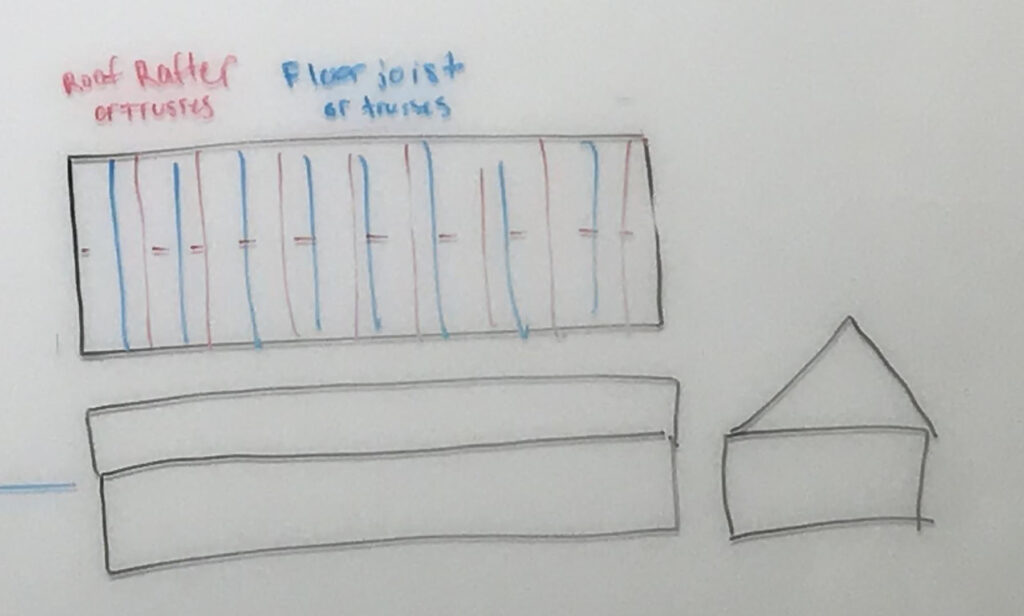We all know the significance of altering a home’s structural system.
Accidentally removing a load bearing wall can cause severe on-going issues for homes or other building structures!
Let’s go over how to tell if a wall is load bearing.

Before we jump in, we want to you to be aware that your city government will most likely require you to have a structural engineering inspection to determine if a wall is load bearing prior to removal.
This is because altering a home’s structural system without a structural engineer’s inspection or a lot of self study may be a significant short or long-term problem of the “domino effect”.
Your home or building could become a house of cards!
Yikes!
However, understanding the basic concepts of load bearing walls will allow you to budget and ask your structural engineer for feedback on your remodeling plans.
Here we go.
1) What is a load bearing wall?

Load bearing walls are structural elements in the home that help to transfer weight from the roof, through the floors, and down to the foundation.
If you remove a load bearing wall without replacing it with the proper supports, you remove a vital part of the structural system working to keep your home standing.
Since loads are transferred from one level of the home to the next, it is common to find load bearing walls directly over one another on each floor. Notice I said common, but not absolute.
2) Anatomy of a load bearing wall
Knowing what makes a wall load bearing is essential for locating them. Notice image 2 below. This wall has a base plate (a single 2×4 or 2×6), studs (single 2×4 or 2×6), and doubled up top plate (2-2×4 or 2×6).
There should be 2 tops plates in order to support the floor joists and prevent sagging and failure.
Floor joists (typically 2×6 up to 2×12) are structural members used for transferring loads to vertical members.

The floor joists in this particular photo are running perpendicular to the wall and end on this wall which indicates that it is most likely load bearing.
If the joists were continuous over the top of the wall, depending on the loads above and below the wall, it could be non load bearing. A structural engineer would be needed to determine this.
Here’s a great video to help explain anatomy.
3) What to Expect
Before we dive in and provide you with the steps required to get a general sense of the load bearing walls in your home, we want to prepare you for what’s to come.
Be aware that most cities will require you to pull a permit for remodels, especially if you plan to alter structural components.

Even if you or a skilled contractor has experience determining load bearing walls, the city (in nearly every situation) will require a structural engineer to sign off on the plans.

Although this may feel like an obstacle stopping you from progressing with your project, it’s really for a good reason.
For example, most people would look at image 2 and assume that because the joists run perpendicular to the wall and because they end on that wall, the wall is load bearing.
However, if a structural engineer looked at that sketch (image 2) they would tell you, “it might be load bearing, but an onsite inspection to look at your attic, foundation, and your structure is a must.”
There are no sure bets.

Opening up a wall can be like a pandora’s box of anomalies!
Structural engineer’s are trained to find things like undersized members (building elements) which could mean: 1) tons (literally) of deflection or “bounciness” or 2) understrength or insufficient framing elements leading to structural failure or building collapse.
Structural Engineers can also provide you with documentation that your wall was inspected which can protect you.
If the wall is load bearing, many engineers will provide you with a scope of work that your contractor can use to perform structural alterations correctly and to meet required building codes.
4) Basic Steps to Determine Load Bearing Walls
A) Look at any given wall you think you will want to remove. If the drywall is open, this process will be much easier.
You will need to look at the floor/ceiling joists. Notice how in the picture below the floor joists are running perpendicular to the wall. This could mean the wall is load bearing, but is not enough information to say for sure.

Source

B) Next, follow the wall up through the levels of your home. Does the wall stretch up through the floor directly above itself? If so, this is another clue leading us to believe the wall could be load bearing.
C) Head to the attic. Licensed Structural Engineer, Stephen Hammill, Complete Building Solutions says, “A lot of it comes down to where the roof rafters and trusses bear when determining what walls are load bearing.” With that being said:
1) Do you notice ceiling joists stopping and starting perpendicularly over the wall? 2) Do you notice braces going from the rafters downwards onto the wall? If either of these scenarios are true, it’s highly likely that you have a load bearing wall.
The picture below demonstrates ceiling joists resting on the wall as well as braces which transfer the load from the roof down to the wall.

5) The Myth about Exterior Walls:
Myth: All exterior walls are load bearing. Truth: It’s common that all exterior walls in a home are load bearing, but not guaranteed.
Many people assume that all exterior walls are load bearing, period. This is not always the case. It comes down to where the floor joists and trusses bear which varies depending on the type and style of house.
Engineer, Stephen Hammill, P.E., drew us a simple sketch to explain.

Image 9 depicts a house that has floor joists and roof trusses running perpendicular to each other (top view). They are rotated 90 degrees which means the 4 exterior walls are all load bearing.
Now, look at the picture below. Do you notice a difference in how this house is built? It’s long and skinny comparable to some ranch homes. The roof trusses/rafters and floor joists/trusses are running parallel to each other.
This means that only the two walls the roof trusses/rafters and floor joists/trusses are bearing on are load bearing.

Aha! The myth is busted, exterior walls can be non-load bearing.

6) 4 Factors Structural Engineers Consider when Engineering your New Support System
By now you should have some idea about which walls are load bearing in your home. This may help you make very important decisions about your remodel.

Source
Go ahead and schedule your structural engineering appointment. The engineer can look at the walls you desire to remove and let you know A) Is it load bearing? B) What needs to happen if it is load bearing?
Remember, the structural engineer can look for factors beyond what we listed in step 4. There may be important hidden components of the home which the engineer may want to analyze.
They may also discover a structural defect, such as an undersized beam, which could alter your remodeling plans. Added value…. While you have a structural engineer onsite, why not ask about other concerns like wall or foundation cracks, water intrusion or something else, just ask!
Once they determine the wall is load bearing, a structural engineer will consider several factors as they write the work scope for the replacement support system.
Load path:
Load path is the direction in which each consecutive load (structural weight) will pass through connected members. How a load is distributed helps to determine if a wall is load bearing.
It also helps an engineer create new support systems once the wall is removed. It can be challenging to engineer solutions and lots of math calculations are required.

Uplift
An uplift force is any upward pressure applied to a structure that has the potential to raise it relative to its surroundings. An engineer will consider this force when removing a load bearing wall.
If the wall being removed is resisting wind uplift on the roof, then a replacement structural system will also need to resist wind uplift by providing a continuous load path to the foundation. The foundation weight is able to then resist the uplift.
For this to happen, the connections will need to be engineered properly. An engineer will pay special attention to the connection of beam to post and any connections needed to secure members travelling through floor system.

Blocking:
This is the short pieces of lumber in wood framed construction used for things like filling, spacing, joining, and reinforcing members.
In this case (photo below), blocking is used for continuous path of load down to the foundation. Correctly transferring loads is essential to the health of your home.

Slab Strength/Footings
Frequently, a structural engineer will examine the strength of your slab (common type of foundation formed from a block of concrete) when preparing to engineer a new structural system to replace a load bearing wall.
If the wall you are removing is resisting uplift, then a footing may be required.
If you are only dealing with gravity loads then the slab strength will need to be examined.
If it is strong enough to hold the footprint of the post, no footing will be required. If not, then you will need to cut out a section of the slab, dig down into the soil and install a properly sized footing.

Looks scary? Removal of some of these load bearing walls can be very tricky and the structural engineer will need to go through various calculations and the factors above to engineer the best possible replacement support structure.
Click here to learn more about potential options for removing a load bearing wall.
Summary of how to determine if a wall is load bearing:
- Inspect your home using our guide to help you formulate questions for a structural engineer
- Hire a structural engineer to inspect the desired walls, determine load bearing walls, and provide you with a scope of work that your contractor can use to perform the work SAFELY
- Obtain a building permit using paperwork from the structural engineer
- Give the contractor the greenlight to start the work and have them follow the structural engineer’s scope of work!



